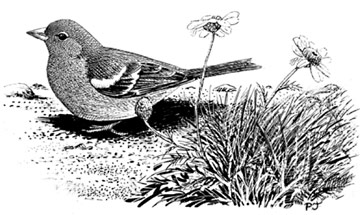
Chaffinch © Phil Jones
In winter, the population of Chaffinches is roughly doubled by immigration from Fennoscandia (BTO Winter Atlas). There are many ringing records in Cheshire and Wirral of birds from Finland, Sweden, Norway and Denmark, and along their migration route here following the coast of Germany, the Netherlands and Belgium. Our breeding birds are resident all year round: their median distance of movement is less than 1 km at all seasons, 90% move no more than 5 km, and the rest, almost entirely first-year birds, less than 50 km (Newton 1972, Migration Atlas). Coward (1910) gave no evidence for his statement that the numbers of our breeding birds were reduced by autumn emigration, and that has probably never been true. In prolonged periods of frost some birds leave to fly to Ireland, but hard weather movements have not occurred for some twenty years.
The map shows that they were found everywhere in winter. Their apparent absence from an odd tetrad here and there can only be the result of bad luck for the observers. They are not limited by altitude or vegetation, and were found in a wide variety of habitats. The submitted habitat codes for winter showed a slight shift to farmland (45%, compared to 37% in the breeding season), with commensurate drops in the other three main habitat classes; 25% human sites, 24% woodland and 5% scrub. Half of the farmland codes were hedgerows, with 5% of the total stubble fields.
The sex ratio of wintering Chaffinch flocks is an interesting subject for amateur observation and has aroused much discussion over the years, ever since Linnaeus in 1758 named the species coelebs (bachelor) because wintering birds in his native Sweden were almost exclusively male. Gilbert White, in letters dated 1768 and 1770 in his Natural History of Selborne, commented on the vast preponderance of females – at least fifty to one – in wintering Chaffinch flocks around Selborne in Hampshire. By 1949, however, males were reported to predominate in the Netherlands, Belgium and Britain, with females in the majority in Ireland. In Cheshire, my ringing from 1980 to 2007 in a variety of feeding flocks and roosts has found just a slight excess of males, 52% : 48% females (Migration Atlas).
In winter the Chaffinch’s diet consists almost exclusively of small seeds which they find on the ground. They have catholic tastes, taking a wider range of seeds than any other finch, but cereal and weed seeds are the most important. It is many years since they earned their name as the chaff-finch, and they would not nowadays be noted as the bird that followed the grain harvest. They lack the specialised bill of some other finches, and cannot cope with seeds that are difficult to extract.
The species’ status has probably not changed much for a century or more. Coward and Oldham (1900) wrote ‘in winter the bird is eminently sociable, and large flocks may be seen in the open fields’ and Boyd (1951) said ‘big flocks roam the woods and fields, and roost in hollies and other evergreens’, comments that could be made today.
Although communal roosts are an obvious feature of this species’ behaviour in winter, not many birdwatchers pay them much attention, and roosts were reported in only 12 tetrads in this Atlas, only three of them with flocks estimated larger than 50 birds. The largest was of 200 birds at Norton Priory, Runcorn (SJ58L), taking advantage of the microclimate, especially shelter from winds, provided by rhododendron bushes under mature trees. Chaffinches gather in the tops of the trees from one hour before dusk, indicating that they seldom have difficulty in finding food and have time to spare even on the shortest midwinter days.
Sponsored by Alastair Jenkins

